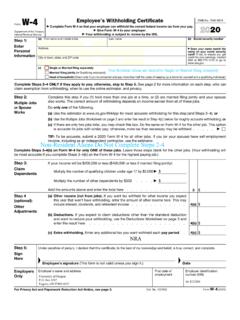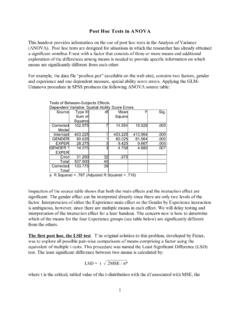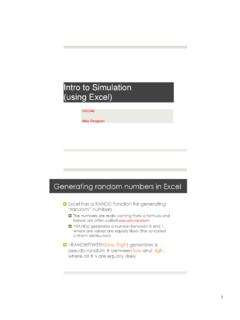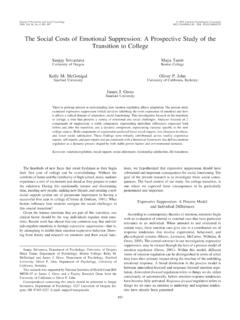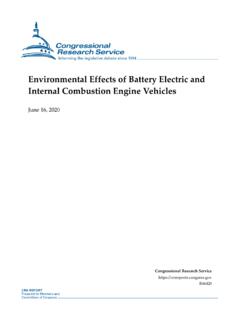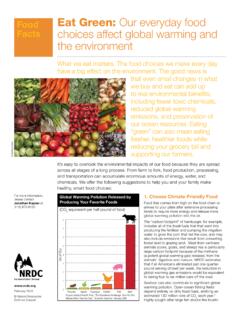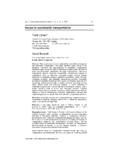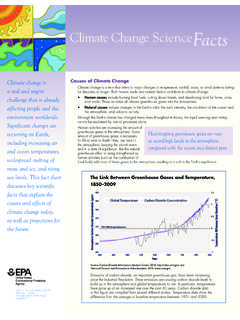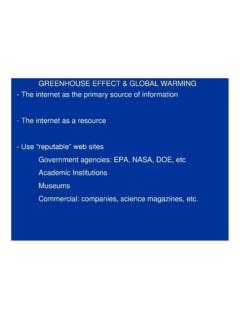Transcription of Effects of Volcanic Eruptions - University of Oregon
1 ACTIVITY OBJECTIVESS tudents will learn: The Effects of a Volcanic eruption on a community. The Effects of a Volcanic eruption on the Earth s environment and geological structure. The different geological features/events of a Volcanic eruption. About the possible warning signs of a Volcanic of Volcanic EruptionsEffects of Volcanic EruptionsEffects of Volcanic EruptionsEffects of Volcanic EruptionsEffects of Volcanic EruptionsMATERIALSTIME REQUIRED 3 to 5 classroom sessions (based on 50 minute sessions) Map of your area (see Procedure no. 2) Access to research materials of local mountains (see Procedure no. 3) Notebook paper Access to computer and printer1 GRADE LEVEL Junior High (with extensions for High Schoolers)This activity complements the Mt. St. Helens and the Volcanic Cascades DVD presentation andgeneral study St. Helens, May 18, 1980 Photograph by Don L.
2 HunterDRAFT VERSION 03/09/06 - DRAFT VERSION 03/09/06 - DRAFT VERSION 03/0906 DRAFT VERSION 03/09/06 - DRAFT VERSION 03/09/06 - DRAFT VERSION 03/09/06 This project was made possiblethrough the Institute of Museum andLibrary Services National LeadershipGrant for Museum and LibraryCollaborationPROCEDURE (NOTE: THESE ARE SUGGESTED STEPS AND CAN BE MODIFIED ACCORDING TO INSTRUCTOR NEEDS AND RESOURCES)21. Divide the class into groups of 2-8 (depending on class size).2. Using a map of the area, each group will determine the closest mountain to your community.(Note: If a possible volcano is not a realistic option for your local community, see the Extensionssection for possible replacement activities.)3. Research that mountain. Is it extinct, dormant, or active as a volcano? When was the last time iterupted, if ever? What type of volcano is it? (See terms.) If it erupted in the documented past,how did it affect the area around it?
3 4. Groups will document a fictional Volcanic eruption of the mountain chosen in # 2 above. Stu-dents will write an outline that describes the various Effects of a Volcanic eruption on their localcommunity. It is important to take past Eruptions into consideration (if applicable).The outline will explain:The extent of: Lava flow destruction Ash fall Changes in the climate Other Volcanic disturbances (earthquakes, mud flows/slides, pyroclastic flows, gases, etc.)The Effects on: Human-built structures Human health Agriculture Livestock Forests Landscape (change in land formations)5. Groups will act as Volcanic experts in a mock Town Hall meeting where they will warn thelocal community of a pending eruption. They will create and present a report (2-3 pages) to thecommunity. Taking the outline described above as a guide, the report will Effects the eruption will have on the community and the historical precedence (ifany) of the mountain should city officials do to ensure the loss of lives and property is minimized?
4 C. What should individual residents do? Should they: Evacuate the community? How far do they need to go to be safe? Bring animals indoors? For how long? Store food and water? Avoid driving? For how long? Other?d. Explain the long-term changes to the environment, and how it will bounce Additionally, groups should anticipate the types of questions community residents wouldask about the VERSION 03/09/06 - DRAFT VERSION 03/09/06 - DRAFT VERSION 03/09/06 DRAFT VERSION 03/09/06 - DRAFT VERSION 03/09/06 - DRAFT VERSION 03/09/0631. What types of Volcanic Effects did you focus on? How do they affect a community? How dothey affect the natural environment? How does a Volcanic eruption fit into the natural cycle ofenvironmental changes?2. Do you think volcanoes or human populations have more impact on the environment? Why doesone have more impact?
5 What are the negative and positive Effects by both volcanoes and hu-mans on the environment?3. What is the most damaging part of a Volcanic eruption (lava flow, pyroclastic flow, ash, bombs,etc.)? Think about damage in terms of lives lost, property damage, or economic disruption(change of flight paths, etc.). From your analysis of the nearest volcano, what is the most dam-aging part of an eruption in your area?4. What types of occupations would be directly affected by a Volcanic eruption? What types wouldbe indirectly affected? Would your job or your parent s job(s) be affected if the nearest volcanoerupted?5. Are there other large-scale natural occurrences that affect communities on such large scales?What are they? What are the differences and similarities among these occurrences and volcaniceruptions?QUESTIONS FOR CLASS DISCUSSIONASSESSMENT Student assessment may be based on the following specific exercises or in combination: Student outlines evaluated in terms of conveying the following information:oThe extent of damage and environmental change created by Volcanic Effects this damage and change has on various populations (human, animal, plant,etc.)
6 And on the landscape. Group presentations for mock Town Hall meeting :oWas the group able to accurately describe the extent of the Effects of Volcanic damage onthe community?oWere the group s recommendations reasonable and clear for the community?oDid the group answer the community s questions in an articulate and accurate manner? Completion of final presentation written paper (2 3 pages) sufficiently addressing:1) The Effects the eruption will have on the community and the historical precedence ofthe mountain ) What city officials should do to minimize the damage caused by an ) What individual residents should ) General conclusions. Participation in class discussion. Matching final student knowledge of the topics in relation to your state VERSION 03/09/06 - DRAFT VERSION 03/09/06 - DRAFT VERSION 03/09/06 DRAFT VERSION 03/09/06 - DRAFT VERSION 03/09/06 - DRAFT VERSION 03/09/064 EXTENSIONS Watch the DVD presentation, Mt.
7 St. Helens and the Volcanic Cascades by Don L. Hunter, andhave a class discussion around the topics presented. Have students research and complete the same activity as previously outlined in the Proceduresection, but instead pick a city (not their own) with a volcano close to it. How did the eruptionaffect this city? Did the community do anything to try to avoid a potential disaster? Is a similarscenario possible in your community?Examples: Yakima, WA Mt. St. Helens (1980), ashfall hazardOutskirts of Hilo, Hawaii downslope from Mauna Loa (1984), lava flow hazardEast of Lassen Volcano, California near Lassen Peak (1914-17), ashfall hazard Find out which natural disaster is most likely in your area. Research what the safety plan is if thatdisaster threatened your area. Have students research how Volcanic Eruptions assist scientists/archaeologists in learning aboutpast human populations and their lifestyles.
8 Have students graph out a certain effect of Volcanic Eruptions (such as the distribution of ashpatterns) in the Cascades over the last 10,000 years. Have students research and present on specific Federal Government agencies involved with themonitoring of natural disasters and how the agency is involved directly in the students commu-nity. Have students create a hazard map of their community and use topography, vent locations, andpotential Eruptions styles to map out possible Effects of a Volcanic VERSION 03/09/06 - DRAFT VERSION 03/09/06 - DRAFT VERSION 03/09/06 DRAFT VERSION 03/09/06 - DRAFT VERSION 03/09/06 - DRAFT VERSION 03/09/06 Ash: Fine material (less than 1/10 an inch in diameter)ejected in an explosive Volcanic eruption, which can containvolcanic glass, crystals, and pulverized rock from the wallsof the Volcanic conduit. These particles are transported bywind from the Volcanic vent into the atmosphere where theycan spread for thousands of miles.
9 Volcanic ash is the mostwidespread hazard from Volcanic Eruptions because of thelarge areas it can Ashfall (Airfall includes pumice): Ashfall is the ash that falls from the eruption cloud ofa volcano, creating layers of ash on the surface of the Ash Flow: see pyroclastic flow (below).Climatic Effects Of Volcanic Eruptions :oOzone effect is the destruction of earth s ozone by the introduction of such chemi-cals as Volcanic aerosol gas particles (or human made CFCs). These chemicals createa hole in earth s ozone layer, which allows harmful ultraviolet rays from the sun toenter the Earth s atmosphere. Volcanic Effects on ozone depletion are minimal andshort lived due to the fact that the aerosol gas particles will dissipate in two to effect is caused by the addition of gases (primarily CO2 and watervapor) to earth s atmosphere. The effect causes a rise in global temperatures; CO2molecules allow short wavelength solar radiation to enter the atmosphere, but absorblong wavelength infrared radiation from the earth s surface, thereby trapping heatenergy that creates a cycle where more radiation is allowed into the atmosphere thanis released.
10 Volcanic Eruptions add to global warming by adding CO2 to the atmo-sphere. Scientists have determined that the amount of global warming caused byeruption-generated greenhouse gases is effect is caused by airborne particles from Volcanic Eruptions that block outenough sunlight to cause a reduction in global tube: A hollow tube in a lava flow formed by drainage of lava after theformation of a solid surface : A surface fracture or crack in rocks; fissures can be located onvolcanic slopes or on active lava domes. Some Volcanic Eruptions originatealong elongated fissures, instead of central vent Flow: A hot gas-supported flow of ash, pumice, and rock particlesthat collapse out of a Volcanic ash column, or boil-over from a Volcanic flows travel downslope at high speeds causing an extreme asphyxiationand burn danger for individuals in the flow Ash, Mt.
